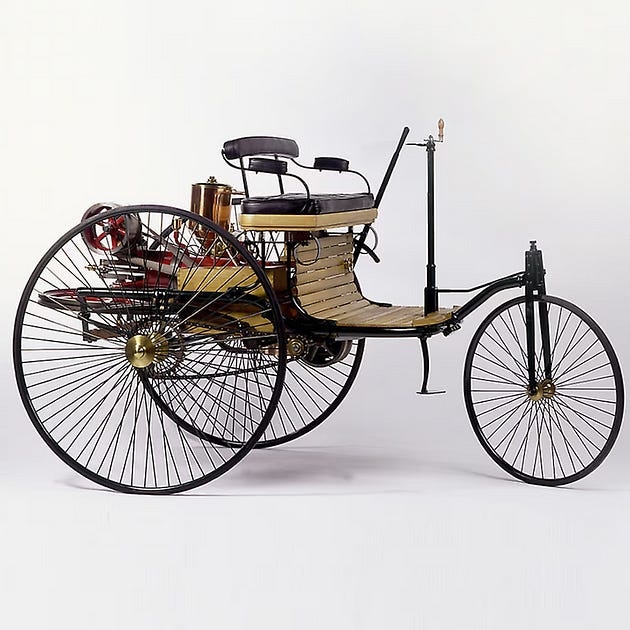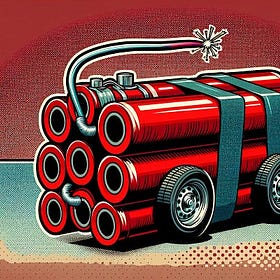The Case For The Automobile.
Pitch it to me.
It’s 1880, and an innovative new technology has been released onto the market. The internal combustion engine. You’re an innovator and entrepreneur and you’ve just had a great idea. This could change the world.
If you powered some sort of carriage with this new engine, passengers could be propelled without using a horse at all.
A horseless carriage?
This is a wild idea that is going to take some effort to design, build, and sell. New, sophisticated technologies almost always require some cash to finance this development, but you’re an experienced entrepreneur and can handle this.
However, you will need a killer pitch.
The chance of this pitch landing will be significantly improved if you can ease the incumbent solution aside. If you can highlight the inadequacies of the established solution whilst you focus upon how your new solution resolves these problems, you are sure to succeed.
About that horse.
What advantage does it offer?
A horse offers an all terrain personal transport. A horse requires little road infrastructure to cross terrain. If no road is available, the horse will still move with ease across rough terrain. In fact, should obstacles be encountered the horse can even leap over this with little interruption to its stride.
A horse offers the original full self-driving system. A horse will not easily crash into another horse or a pedestrian. A horse is unlikely to swerve off a cliff without considerable motivation. You could fall asleep at the reins and will likely be transported entirely safely while you travel.
The horse is powered by grass and water. Across much of the world, you can find grass and water everywhere. In fact, a grass powered vehicle is, strictly speaking, solar powered. This solar charging can keep the horse moving for hours. If you do run out of fuel, you’re likely to easily find this en route. The horse will recharge itself whilst parked.
The exhaust of a horse is environmentally friendly. In fact, horse shit will actually promote the growth of grass, to actively support the renewal of the very fuel that powers the horse.
To ride a horse requires skill, and fitness. To ride a horse for a long period will be tiring. However, ride a horse far enough and you might become quite fit and healthy. If you rode a horse to work every day, you may have no need for that gym membership.
You will look amazing astride that horse.
The horse is an extremely flexible means to provide motive power. A single horse can offer a personal transport. It may even carry two. However, if more horsepower is required you can add them together.
A horse can transform from an all terrain single occupancy transport by assembling a number of horses together. Multiple horses can draw multiple passengers along the road in a carriage. Multiple horses can pull heavy cargo in wagons. Horses can even move boats. These horses can once more be separated, to create multiple all terrain personal transports.
If a horse becomes lightly damaged it is self repairing. The dents will knock themselves out. Under heavy damage, you may need another horse. Fortunately, horses are self replicating. You can use horses to make new horses. If your old horse is damaged beyond repair it will still offer value. There’s no need for a scrap yard.
After all, you can eat a horse.
However, let’s not get ahead of ourselves. No need to make a meal of our trusty personal transport just yet. After all, horses are not only beautiful, but you can also make friends with a horse.
Can you pitch me an automobile that can do all that?
A formal analysis might reject gas powered horseless automobiles on the spot in favour of that horse. Ford is credited with stating, if I had asked people what they wanted, they would have said faster horses.
Did Ford succeed in creating a faster horse?
If you could design a car with the characteristics of a horse now, you’d be onto a winner.
Consider pitching a road vehicle today that exhibits these characteristics. A beautiful, versatile, solar powered, self repairing, self replicating, all terrain vehicle that runs on grass, produces fertiliser, that you can make friends with, or eat if things become desperate.
I think the modern consumer might jump at such a thing. Who, in 1880, knew that 150 years later the entire globe would be desperate for a personal transport that offers these very characteristics.
Subsequent technical development did demonstrate that the automobile could offer road transport at speeds that far outstrip the horse. However, in 1880 you can make no such promises. The Benz Patent-Motorwagen could hit 10 miles per hour. A horse at full gallop can offer four times this speed.
With no assurances in 1880 that you might go faster, now pitch me that ‘horseless’ carriage again.
Will Electric Vehicles Become Bombs On Wheels?
Sometimes we write because we have something to say. Sometimes we write to work something out. Sometimes we write to ask a question. I have a question. Consider the mechanism required to make your automobile explode in a huge fireball. If you have a gasoline vehicle, only half of the chemistry required to do this is actually on board the vehicle. The rest …



